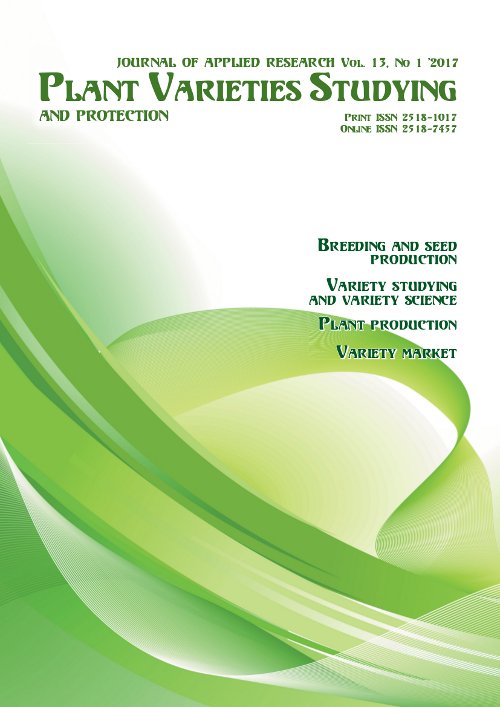Morphological features of Persica species and varieties in the Forest-Steppe zone of Ukraine
DOI:
https://doi.org/10.21498/2518-1017.13.1.2017.97307Keywords:
peach, buds, leaves, fruits, morphometric indexAbstract
Purpose. To determine morphological and morphometric features of vegetative and generative organs of Persica species and varieties under the conditions of the Forest-Steppe zone of Ukraine for further use in breeding.
Methods. Biological (morphological analysis) and statistical (processing of morphometric parameters) ones.
Results. It was found that except ternate multiple buds, in peach hybrid ‘Suputnyk’collateral buds were prevalent which was not common to other tested varieties and species. Buds of each species and variety have a certain number of scales. The most scales were observed in ‘Suputnyk’. Pubescence of abaxial side of the leaf in P. davіdiana and ‘Suputnyk’ plants was not revealed. Species of P. vulgaris (‘Pecherskyi’, ‘Antotsianovyi’, ‘Poleskyi’) was characterized by increase in size of leaf blades, flowers and fruits. The distinctive features of P. davidiana and ‘Suputnyk’ are that stamens were accumulated in their flowers while in P. vulgaris they are branched. Raphe of a P. vulgaris stone protrudes above the edges of the bordering creases and consists of a number of narrow plates.
Conclusions. For the breeding purposes, plants have an advantage for some basic criteria: the most flower buds that is common to interspecies hybrid ‘Suputnyk’; increase in photosynthetic productivity of the leaf apparatus to be typical for the variety ‘Pecherskyi’; large fruits that ‘Pecherskyi’ variety is noted for; intense red color of fruits that is inherent feature of ‘Antocianovyi’ variety.
Downloads
References
Eremin, G. V. (1986). Breeding of stone fruits in the industrial production zone. Sbornik nauchnykh trudov VNIIS imeni I. V. Michurina [Proceedings of the All-Soviet Research Horticulture Institute named after I. V. Michurin], 48, 42–48. [in Russian]
Zayats, V. A. (1992). Features of blossoming of introduced peach varieties relative to frost resistance. In Izuchenie ontogeneza introdutsirovannykh vidov prirodnykh flor v botanicheskikh sadakh [Study of ontogenesis of introduced species of the natural flora in botanical gardens] (pp. 42–43). Kiev: N.p. [in Ukrainian]
Klochko, N. M. (2008). Peach trees collection is a source of economic characters in breeding. Genetichnі resursi roslin [Plant genetic resources], 6, 174–179. [in Ukrainian]
Artyushenko, Z. T. (1990). Atlas po opisatel'noy morfologii vysshikh rasteniy. Semya [Alas of descriptive morphology of higher plants. Seed]. Leningrad: Nauka. [in Russian]
Artyushenko, Z. T., & Fedorov, A. A. (1986). Atlas po opisatel'noy morfologii vysshikh rasteniy. Plod [Atlas of descriptive morphology of higher plants. Fruit]. Leningrad: Nauka. [in Russian]
Fedorov, A. A., Kirpichnikov, M. E., & Artyushenko, Z. T. (1956). Atlas po opisatel'noy morfologii vysshikh rasteniy. List [Alas of descriptive morphology of higher plants. Leaf]. Moscow; Leningrad: Izd-vo AN SSSR. [in Russian]
Fedorov, A. A., Kirpichnikov, M. E., & Artyushenko, Z. T. (1962). Atlas po opisatel'noy morfologii vysshikh rasteniy. Stebel i koren [Atlas of descriptive morphology of higher plants. Stem and root]. Moscow; Leningrad: Izd-vo AN SSSR. [in Russian]
Fedorov, A. A., & Artyushenko, Z. T. (1975). Atlas po opisatel'noy morfologii vysshikh rasteniy. Tsvetok [Atlas of descriptive morphology of higher plants. Flower]. Leningrad: Nauka. [in Russian]
Levon, V. F., & Golubkova, I. M. (2016). Accumulation of anthocyans in aerial organs of the genus Persica Mill. in different periods of vegetation. Visnyk problem biolohii i medytsyny [Biology and Medicine Issues Review], 2(3), 79–83. [in Ukrainian]
Downloads
Published
How to Cite
Issue
Section
License
Copyright (c) 2017 Ukrainian Institute for Plant Variety Examination

This work is licensed under a Creative Commons Attribution-ShareAlike 4.0 International License.
Starting in 2022, the copyright to the publication remains with the authors
Our journal abides by the CREATIVE COMMONS copyright rights and permissions for open access journals.
Authors, who are published in this journal, agree to the following conditions:
- The authors reserve the right to authorship of the work and pass the first publication right of this work to the journal under the terms of a Creative Commons Attribution License, which allows others to freely distribute the published research with the obligatory reference to the authors of the original work and the first publication of the work in this journal.
- The authors have the right to conclude separate supplement agreements that relate to non-exclusive work distribution in the form in which it has been published by the journal (for example, to upload the work to the online storage of the journal or publish it as part of a monograph), provided that the reference to the first publication of the work in this journal is included.

























 Ukrainian Institute for Plant Varieties Examination
Ukrainian Institute for Plant Varieties Examination  Селекційно-генетичний інститут
Селекційно-генетичний інститут Institute of Plant Physiology and Genetics of the National Academy of Sciences of Ukraine
Institute of Plant Physiology and Genetics of the National Academy of Sciences of Ukraine
 The National Academy of Agrarian Sciences of Ukraine
The National Academy of Agrarian Sciences of Ukraine